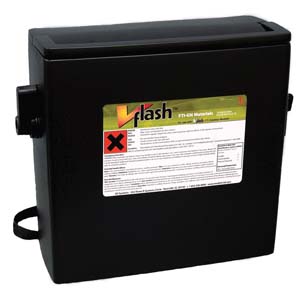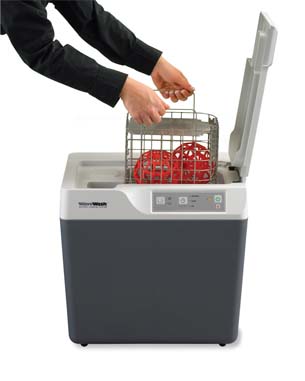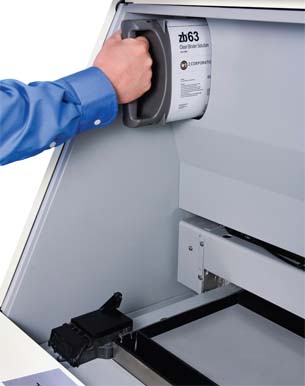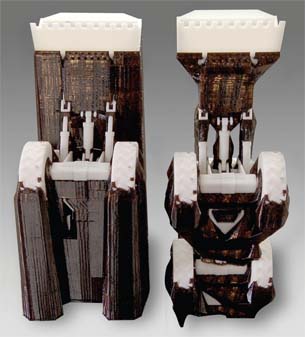Going Green with Rapid Tech
Reducing both materials and the weight of transported components are key benefits of additive manufacturing processes.
January 1, 2011
By Susan Smith
 The V-flash cartridge is completely self-contained and is recyclable via 3D Systems’ recycling center. Image courtesy of 3D Systems. |
Many years ago, Kermit the Frog made a profound statement: “It’s not easy being green.” Little did he know that being green would become a catchphrase in the 20th and 21st centuries, a goal for every business wanting to demonstrate its commitment to saving the ailing planet.
Traditional manufacturing processes have come under scrutiny by green watchers because of the large carbon footprint they leave when moving large manufactured parts, such as those belonging to aircraft or automobiles. In addition to the manufacturing impact, they incur greater fuel consumption and add time to the design-to-manufacture process. They also can produce a great deal of waste products.
On the other hand, additive manufacturing (AM) processes and material types are thought to generate less waste and less weight, in general, which reduces the amount of material that goes into the finished product. They also have been known to reduce the time it takes to design and manufacture products.
Issues to consider when comparing AM to traditional manufacturing processes include:
• Recycling materials, waste products and disposal.
• Weight of materials and finished products, leading to fuel consumption in transport.
• Reducing design and manufacture time.
According to Drs. Christopher Tuck and Richard Hague of the Additive Manufacturing Research Group, Loughborough University, UK, AM can reduce the carbon footprint in some ways, even while they add to it in other ways. The real environmental benefits of AM come from reducing material and reducing the weight of components that are transported.
 Stratasys’ WaveWash cleaning system dissolves the brittle plastic support material from models made with Dimension 3D printers. Image courtesy of Dimension 3D. |
Tuck and Hague spearhead the Atkins Project, a $4.6 million collaborative research and development project funded by the UK government and a consortium of leading industrial partners. The aim of Atkins is to migrate the design, manufacturing and distribution of products and parts away from the high energy-intensive processes used in many organizations to a more sustainable method of production, service and distribution to the consumer.
Because there are several different AM systems, it is hard to quantify the amount of waste for AM in general. Tuck says that some of the systems produce considerable waste products, noting that “where the design uses a similar amount of material or doesn’t improve on the performance of the product, the use of AM may actually increase the carbon footprint.
“For polymers, laser sintering is only around 20% material efficient at best, with only a certain portion of the remaining material able to be recycled,” he adds. “Again, for complex or lightweight products, this may be better than for competing manufacturing technologies, but it is not correct to say there are little waste materials. For other polymer systems, there are support structures that are either land-filled or dissolved into waste water again.”
Depending on the product in question, this can be a large amount of material. For metal products, the waste streams are significantly less, where unused powder can be almost 100% recycled (agglomerates require removal) in powder bed systems (i.e. service lifecycle management ]SLM] or e-beam). In each of these aforementioned systems, however, support structures must be removed and recycled. “In addition, there are filter systems within these metal machines that require disposal,” Hague says.
Most of the results from Atkins stem from energy monitoring and component redesign. “We are typically seeing 50% weight reductions on our ‘optimized’ components; however, we still need to validate these designs and the production methods,” says Tuck. “We also have a beta-test version of carbon footprint mapping software that is capable of letting manufacturers know what inherent carbon content is within their products, made anywhere in the world with both traditional and AM systems.”
Materials Management and Handling
Tuck says a portion of polymer laser sintering powder (PA12) can be recycled, but it needs continual mixing with fresh powder (roughly a 60:40 ratio). This inevitably leads to a large amount of waste. By comparison, support structures in other polymer systems are generally landfilled or dissolved using water.
Some vendors have found a way around that process, however. 3D Systems’ ProJet is an inkjet 3D printer that uses photocurable resins to produce parts.
 The ZPrinter is run under negative pressure to contain the small particles of powder in its powder-based process. Image courtesy of Z Corp. |
“We have formulated support materials out of paraffin wax, which is an inert, friendly substance,” says Buddy Byrum, senior director of management product marketing for 3D Systems. “When our parts are built, the materials are in fully closed cartridges. They don’t require any exposure of the operator to any non-friendly materials, and the process in the machine fully cures the plastics. So when you take a part out, you’ve got a plastic part that you can handle, and the support material simply melts away into an inert wax that doesn’t have disposal hazards.”
3D Systems’ VFlash has a thin, small and non-dense support structure, enabling it to break off easily, and generates no in-process waste in the machine. Byrum says 3D printers have traditionally had a significant amount of in-process waste. “VFlash uses up all the material that is put into it,” he says.
ZP 150 is a material used for all ZCorp 3D printers except its ZBuilder, which uses polymers. The ZP 150 material is not harmful to the environment and does not involve photopolymer-based materials, according to the company.
“The ZPrinter 150 and 250 are intended for small group use and being right next to the desk, so you don’t want to be ingesting chemicals,” says Joe Titlow, vice president, product management. “The user of the machine is going to be a person without training in how to deal with chemicals. You don’t get any training for how to deal with the ink cartridges you put in your printer, and that’s the same model we try to follow.”
ZCorp subscribes to a powder-based process, which diminishes the amount of waste that would be the byproduct of some supports. The powder used for a temporary support in the build process needs to be 100% recyclable and reusable in the machine in real time, which is a feature of the most recent 150 and 250. The ZPrinter is run under negative pressure to contain the small particles of powder.
“They get put through a filtering and vacuum system that filters them out of the air and actually deposits them right back into the powdered stream, so that none of it’s wasted during the build,” says Titlow. “It keeps the air and the surfaces around the machine much cleaner.”
The RapMan Kit from Technology Education Concepts (TEC) runs with two key materials: acrylonitrile butadiene styrene (ABS) and polylactic acid (PLA). Both of these materials are supplied to the machine on spools, and 100% of the material from the spool can be used. The only waste that occurs during part build comes from the support structure.
ABS is a common plastic material that can be shredded and then recycled (yet still maintains its plastic properties); PLA is a biopolymer, and therefore biodegradable and environmentally friendly. It is capable of building large parts, but with the crucial benefit that the lifecycle of the part itself has zero carbon impact on the environment.
Solido’s 3D desktop prototype printer, the SD300 Pro 3D printer, enables users to use CAD specifications to cut, glue and layer engineered plastic sheets from a spool, a process known as laminated object manufacturing (LOM).
As the process allows nested multiple parts to be run simultaneously, there is less leftover waste product. The other green plus of this printer is that the consumable material is non-toxic and can be peeled away with forceps supplied with the machine.
Dimension 3D Printing, a brand of Stratasys Inc., launched its WaveWash cleaning system that dissolves the brittle plastic support material from models made with Dimension 3D printers. This cleaning system requires no gloves, goggles or other protective wear. The pH level of the cleaning solution generally meets drain water requirements worldwide.
According to Public Relations Manager Joe Hiemenz, the model is submerged in the tanks, and the system automatically fills with water and drains at the end of the cycle. There is a powder in a dissolvable packet inside another packet that never is released into the air, as it goes directly into the water and does not become loose until it is in the water. WaveWash weighs 36 lbs. and is 18.24x17 in. With an 8x8x6-in. part capacity, it has a 2- or 4-gal. water level and selectable cycle lengths.
 SMART Supports from Stratasys generate supports that use less material during the part building process. Note the supports “before” and “after” processing in this photo. Image courtesy of Stratasys. |
Another effort from Stratasys is the part support style called SMART Supports, which generates supports that use less material during the part building process. SMART Supports is said to reduce build time up to 14%, and lowers material cost by reducing consumption up to 40%. SMART Supports are a user-selection option for Fortus 3D Production Systems and Dimension 3D printers.
EOS also addresses the disposal of powder materials. It has adopted integrated process chain management (IPCM) now also for EOSINT M systems, a process that allows for the reuse of powder materials. Powder is sieved quickly under defined conditions before its reuse. The powder is prepared outside the machine via powder homogenization, to help ensure high quality and flexibility. The IPCM-product range includes multi-purpose lifting trolleys for transporting powder containers, building platforms and clamping systems, as well as for other uses.
Recycling Programs
Manufacturers are also sensitive to recycling issues. Most note when their materials are recyclable—and some even offer their own programs.
3D Systems offers a V-Flash recycling program for the material cartridges as well for the post-processing materials that are used to wash and clean the parts. Recycling centers located in the U.S. and Europe allow customers to return them.
3D Systems also offers trade-up programs for ProJet customers to take in existing machines and re-manufacture and recycle components for use in new machines, avoiding scrapping parts from old machines, thereby reducing the energy and material consumption of building new parts.
All packaging for Stratasys 3D printers, including the spools of material and the cartridges they go into, are recyclable. The fused deposition modeling (FDM) process, used by all Stratasys machines, uses only material necessary to build a part without incurring waste.
ABS plastic models are fully recyclable through any company’s regular industrial materials recycling program, and most AM vendors will have a way to return cartridges and materials. For example, Solido has a recycling program where every SD300 Pro 3D printer shipped will include a pre-paid pouch for sending back excess material and consumables containers for recycling. Customers will receive “green points” to use toward credit on their next order of consumable products.
Objet Geometries’ material can be recycled with any plastic recycling program once cured and printed by an Objet 3D printer. In addition, Objet announced a program for its customers to send back all used plastic resin cartridges to Objet U.S. headquarters, and another program to dispose of unused waste resin from its printers.
| Research Notes The following are the Atkins Project areas of investigation. • Waste minimization during production. Ensuring optimized and repeatable AM production systems can substantially reduce or eliminate waste materials. • Process efficiency gains. Use AM processes to replace inefficient and wasteful conventional manufacturing processes. • Reducing transportation. Using digital supply chains and AM technologies to significantly reduce logistical requirements by shortening the supply chain and minimizing the need for waste material disposal or recycling. • Product design for whole lifecycle impact. Exploiting AM design freedoms to minimize weight for significant reductions in greenhouse gas emissions over the whole product lifecycle. • Product design for optimized performance. Manufacturing truly optimized products that are more efficient in their application compared to traditional parts constrained by design for manufacture. |
Energy Efficiency
Tuck says that in terms of machinery, AM uses very little energy during processing compared to traditional manufacturing on a per-hour basis.
“However, the amount of material processed (i.e. sintered or deposited) per hour is much lower than that processed with traditional manufacturing systems,” he says. “So the overall energy consumption for a part may be higher for an identical same part conventionally produced. The benefit for AM comes when the design cannot be manufactured by other means, and/or uses less virgin material and offers a performance advantage over a traditionally designed product.”
Manufacturers can limit the environmental impact of AM processes by producing products faster.
“Speed is the key to both economics and to the environmental footprint of the machinery. If more material can be consolidated with a similar energy input, all the better,” says Tuck.
The volume of waste from support materials can be minimized by a well-designed part and part orientation on the machine.
ZCorp’s efforts to make machines more energy-efficient have resulted in an optimized process that eliminates the need for a heater in the machine. In addition, the company has changed motors.
“There’s a big blower motor inside that creates the vacuum that we’ve used,” says Titlow. “We downsized it through one engineering effort. The new one draws significantly less electricity. We’ve got an optimized sleep mode for the machine, so if you’re not using the machine for a certain amount of time, it shuts itself down and goes to sleep.”
Faster, more efficient production runs, the nesting of multiple parts to be run simultaneously, the increase of non-toxic substances for both supports and cleaning solutions, recycling, re-engineering, re-design and research all contribute to the greater good in terms of going green with additive manufacturing. But how will Atkins’ findings influence the additive manufacturing of the future?
“I think that Atkins could have serious implications for future manufacturing,” says Tuck. “Being able to use less material is of significant importance in a world where there are fewer readily available resources. Coupling this with more effective designs that are ‘optimized’ for performance and weight saving shows benefits not just for the environment, but also for business, making products more efficient—and thereby more saleable.”
More Info:
3D Systems
Additive Manufacturing Research Group
Atkins Project
Dimension Printing
EOS
Objet Geometries, Ltd.
RapManUSA
Solido
Stratasys
Technology Education Concepts
Contributing Editor Susan Smith is DE’s expert in rapid technologies and has been immersed in the tech industry for more than 17 years. Send e-mail about this article to [email protected].
Subscribe to our FREE magazine, FREE email newsletters or both!
About the Author
DE’s editors contribute news and new product announcements to Digital Engineering.
Press releases may be sent to them via [email protected].






